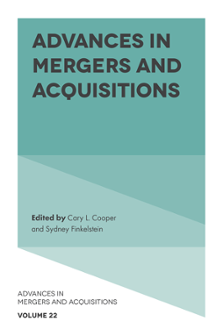
Index
Advances in Mergers and Acquisitions
ISBN: 978-1-83753-861-4, eISBN: 978-1-83753-860-7
ISSN: 1479-361X
Publication date: 24 August 2023
Citation
(2023), "Index", Cooper, C.L. and Finkelstein, S. (Ed.) Advances in Mergers and Acquisitions (Advances in Mergers and Acquisitions, Vol. 22), Emerald Publishing Limited, Leeds, pp. 179-185. https://doi.org/10.1108/S1479-361X20230000022012
Publisher
:Emerald Publishing Limited
Copyright © 2023 Cary L. Cooper and Sydney Finkelstein
INDEX
- Prelims
- Chapter 1: Addressing Information Asymmetry in Acquisitions: The Role of Social Ties
- Chapter 2: The Role of Sustainability in Mergers & Acquisitions: A Literature Review
- Chapter 3: Effects of Human Factors on Knowledge Sharing During Chinese Cross-Border M&A Integration: A Dual-Case Study
- Chapter 4: A Triadic Process View of Divestors, Targets, and Acquirers
- Chapter 5: Private Company Seller Perspectives in Lower-Middle Market M&A
- Chapter 6: Acquirer's Search for a Partner: The Role of Inter-Organizational Relationships
- Chapter 7: A Review and Future Research Opportunities of The Post-Merger Integration Research Using The Social Network Perspective
- Chapter 8: Reflections on Urgency in Mergers and Acquisitions: Views, Reviews, and Directions for Future Research
- Chapter 9: How Private Equity Investors Drive M&A Performance
- Chapter 10: Micro-Foundations in Mergers and Acquisitions Research: Exploring The Case of Emotions
- Index